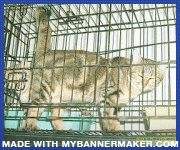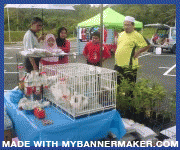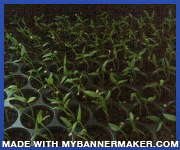DebMark Rabbit Education Resource
Breeding Rabbits
Definitions
* A female rabbit is called a doe. A male rabbit is called a buck.
* When referring to the parents of a rabbit, the mother is called the dam, and the father is called the sire.
* When you mate two rabbits together, this is called breeding.
* When you check to see if the doe is pregnant or when you breed her again before she is due to give birth, this is called testing.
* When you put a box in the hutch that is lined with hay, this is called nesting.
* When the doe gives birth, this is called kindling.
* The period of time between breeding and kindling is called the gestation period.
* She gives birth to a bunch of bunnies called kits. This bunch of bunnies is called a litter.
* When you take the young rabbits away from the mother, this is called weaning.
Introduction
A small breed doe is normally ready to mate when she is 5 months old, and a buck is ready at 6 months. The medium size doe is ready to breed when she is 6 months old and the buck at 7 months. The heavy breed doe is ready at 8 months and the buck is ready at 9 months.
It's usually a good idea to select rabbits to breed whose ancestry has evidence of good productivity and good genetics. That's where productivity records and pedigrees listing show winnings come in handy. Keep productivity and show records of your herd just for this purpose.
You may keep a ratio of one buck to 10 does if you wish. The buck may be bred up to 7 times a week effectively. Sometimes, you can use the buck twice in one day. The most I use a buck is twice a week.
Keep the following principles in mind when you want to breed your rabbits:
* Only mate rabbits of the same breed. See Rabbit Raising - The Basics. Exceptions to this include breeding for meat, pets or genetic experimentation. You cannot sell a pedigree rabbit that has mixed blood in its background going back 4 generations.
* Do not keep more than one rabbit in each cage when the rabbit is 3 months or older. Rabbits mature faster when alone, do not fight, and do not breed, thus eliminating unexpected results.
* Before breeding, check the bottom of the cage of both the doe and buck for evidence of diarrhea or loose stools. Do not breed the rabbit having this condition until it has been adequately treated. Also check the genitals of both rabbits for any signs of disease or infection (for example, extreme redness, discharge, sores or scabbiness). Refer to the ARBA Official Guidebook section on diseases.
* When ready to breed the doe, take it to the buck's cage. Never bring the buck to the doe's cage. The reason for this is that the buck has less tendency to breed in the doe's cage. He's too busy sniffing around the cage.
* Some leave the doe with the buck overnight. Others put the doe in, watch it, and when they have mated, remove the doe. If you do the latter, put the doe back in with the buck 1 to 12 hours after the initial breeding. This will increase the likelihood of pregnancy and may increase the number of offspring.
* Keep a calendar and accurate records of the day you breed the doe. You should test her for pregnancy between the 10th and 14th day after the initial breeding. There are two ways to do this. The overall preferred method is to palpate the lower abdomen of the doe with your thumb and forefinger checking for nodules about the size of a marble. The other method is not only more risky but also more inaccurate. This method is to mate the doe with the buck again. This can cause problems because the doe has two uterine horns, each of which can carry babies. It is possible for one horn to be fertilized on the first mating and the second to be fertilized on the second mating. This will create a hormonal imbalance and cause the babies in both uteri to not form right, causing her to pass blobs instead of babies at the date of kindling. There is also a chance these "mummified" blobs could cause complications leading to the death of the doe.
* You should place a nest box in her cage on the 29th day after breeding. Thirty-one days after breeding, she should kindle her litter.
Who Can Be Bred To Whom?
Never breed brothers to sisters. Other combinations are fine: father-to-daughter, mother-to-son, cousins, etc. Until you gain some knowledge as to how genetics works with inbreeding, I would recommend your not breeding closely related pairs.
As mentioned before, mate the same breeds together unless you are trying to get meat rabbits with certain characteristics or you are doing genetic experiments or you don't care about the fate of the offspring. You cannot sell the offspring as pedigree if their ancestry is not of the same breed going back four generations.
You may mate rabbits of the same breed having different colors. Keep in mind, though, that there are many combinations of possibilities when mixing colors. Some of the offspring may have colors that are not recognized by ARBA. It is usually best to mate rabbits having the same color to start off with until you know more about how the colors interact. See the section on genetics for more information on colors. Also, join the national specialty group for the breed you are interested in raising. They usually have literature on how to develop the best color, size, and shape of your rabbit.
Avoid breeding rabbits that have genetic defects such as tooth malocclusion (wolf teeth) or moon eye (cloudy cornea), or produces offspring whose skull does not come together (except in dwarfs, where approximately 25% are born too small with deformed head or legs - the offspring are called peanuts). Determine whether the sire or dam is responsible for passing the genetic defect and eliminate it for breeding purposes.
Strive to meet the perfect standard for the breed you are mating. Order the ARBA Standard of Perfection Booklet to know exactly what is expected of the breed. Also, join the national association for that breed to get their manual on the breed. Check out the ARBA web page for a list of associations. This will show you how to improve your herd.
Evaluating A Rabbit's Reproductive Life
A rabbit may normally start breeding at the age of 6 months for the small to medium size breeds and 8 to 9 months for the heavy breeds. The gestation period (time between breeding and kindling) is 31 days. After the doe has kindled, I normally re-breed her at 6 weeks and wean the litter at 5-7 weeks. This cycle continues until she is about 4 years old or until her production is unsatisfactory.
I review the herd records every quarter to determine which rabbits are not producing up to par and eliminate them. In October through December, some rabbits go into what is called moulting. At this period, many do not conceive. If you have lights on all the time in your rabbitry, this will help. Rabbits are like chickens that lay eggs only if there is enough light. Raising most of my rabbits outside, I take this problem into consideration when evaluating them. Also, if it gets too hot in the summer, especially for those who live in the Southern U.S., the buck produces less viable sperm and the conception rate goes down. Some people keep their bucks air conditioned to keep the conception rate high.
My minimum standard for a doe is that she produce at least the following number of rabbits per year all the way to weaning:
* Dwarfs: 8
* Small Breeds: 14
* Medium Breeds: 16
* Meat Type: 20
* Giants: 16














